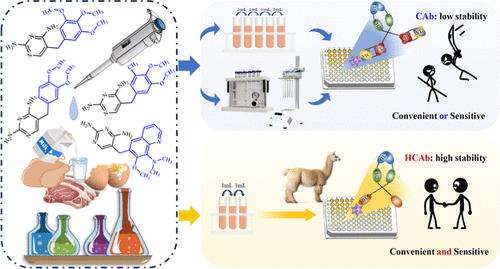打破敏感性与便利性的权衡:一种基于骆驼类hcab的免疫分析法,用于最少预处理食品中抗菌增效剂的多重残留检测
IF 6.2
1区 农林科学
Q1 AGRICULTURE, MULTIDISCIPLINARY
引用次数: 0
摘要
常规抗体(ConAbs)在食品基质或靶提取试剂中的不稳定性往往限制了免疫测定的便利性或灵敏度。本研究用水溶性佐剂免疫羊驼,诱导抗抗菌增效剂(ASGs)重链抗体(hcab)。与ConAb C5相比,HCAb H5在63℃、pH 3.0-11.0、6.0 mol L-1 NaCl、30%甲醇、30%乙腈等恶劣条件下表现出更强的稳定性(结合活性80%,IC50变化2倍)。基于H5的间接竞争ELISA (icELISA)对甲氧苄啶(TMP)、二甲氧苄啶(DVD)、奥美托啶(OMP)和巴喹啶(BQP)的IC50分别为1.24、1.44、1.60和2.11 μg L-1,交叉反应率分别为100%、86.3%、77.7%和56%。样品制备简化为最小稀释步骤─鸡肉、鸡蛋、猪肉和牛奶样品分别仅稀释2倍、4倍、4倍和8倍─整个预处理可在1-8分钟内完成。检出限为0.14 ~ 1.36 μ L-1 /μ kg-1,加样回收率为76.4 ~ 107.3%,变异系数< 14.1%。这是首个基于hcab的ASGs icELISA,对复杂的食物基质具有高灵敏度、鲁棒性和最小化预处理。本文章由计算机程序翻译,如有差异,请以英文原文为准。

Breaking the Sensitivity-Convenience Trade-off: A Camelid HCAb-Based Immunoassay for Multi-Residue Detection of Antibacterial Synergists in Foods with Minimized Pretreatment
The instability of conventional antibodies (ConAbs) in food matrix or target extraction reagents often limits the convenience or sensitivity of immunoassays. In this study, alpacas were immunized with water-soluble adjuvants to induce heavy chain antibodies (HCAbs) against antibacterial synergists (ASGs). Compared to ConAb C5, the HCAb H5 exhibited superior stability (binding activity >80% and IC50 change <2-fold) under harsh conditions (63 °C, pH 3.0–11.0, 6.0 mol L–1 NaCl, 30% methanol, 30% acetonitrile). An indirect competitive ELISA (icELISA) based on H5 showed IC50 values of 1.24, 1.44, 1.60, and 2.11 μg L–1 for trimethoprim (TMP), dimethoprim (DVD), ormetoprim (OMP), and baquiloprim (BQP), with cross-reactivity rates of 100%, 86.3%, 77.7%, and 56%, respectively. Sample preparation was simplified to minimal dilution steps─chicken, egg, pork, and milk samples were diluted only 2-, 4-, 4-, and 8-fold, respectively─and the entire pretreatment could be completed within 1–8 min. The limits of detection (LODs) ranged from 0.14 to 1.36 μg L–1/μg kg–1, with recoveries of 76.4–107.3%, and coefficients of variation (CV) below 14.1%. This is the first HCAb-based icELISA for ASGs, offering high sensitivity, robustness, and minimized pretreatment for complex food matrices.
求助全文
通过发布文献求助,成功后即可免费获取论文全文。
去求助
来源期刊
CiteScore
9.90
自引率
8.20%
发文量
1375
审稿时长
2.3 months
期刊介绍:
The Journal of Agricultural and Food Chemistry publishes high-quality, cutting edge original research representing complete studies and research advances dealing with the chemistry and biochemistry of agriculture and food. The Journal also encourages papers with chemistry and/or biochemistry as a major component combined with biological/sensory/nutritional/toxicological evaluation related to agriculture and/or food.

 求助内容:
求助内容: 应助结果提醒方式:
应助结果提醒方式:


